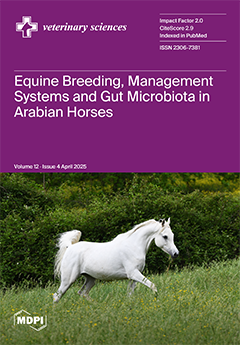(1) Background: The ongoing panzootic of highly pathogenic avian influenza virus (HPAIV) of subtype H5N1, clade 2.3.4.4b, has decimated wild/domestic birds and mammals’ populations worldwide with reports of sporadic cases in humans. (2) Methods: This study aimed to compare the mutational profile of H5N1 avian Influenza virus isolated from a Peruvian natural reserve, with recent data from other related international studies made in human and different species of domestic and wild birds and mammals. Briefly, the near complete protein sequences of the Influenza virus coming from a
Calidris alba were analyzed at a multisegmented level, together with 55 samples collected between 2022 and 2024 in different countries. Moreover, the glycosylation patterns were also predicted in silico. (3) Results: A total of 603 amino acid changes were found among H5N1 viruses analyzed, underscoring the detection of critical mutations HA:11I, HA:211I, HA:336T, HA:492D, HA:527I, NA:10T, NA:269L, NA:405T, NP:377N, PA:57R, PA:68S, PA:322V/L, PA:432I, PB2:539V, PB1:207R, PB1:375N, PB1:264D, PB1:429R, PA-X:250Q, PB1-F2:65R, and PB1-F2:42Y, as well as PA:13V, PA-X:13V, PA20T, PA-X:20T, PA:36T PA-X:36T, PA:45S, PA-X:45S, PA:57Q, PA-X:57Q, PA:61I, PA-X:61I, PA:68S, PA-X:68S, PA:70V, PA-X:70V, PA:75Q, PA-X:75Q, PA:85T, PA-X:85T, PA:86I, PA-X:86I, PA:100I, PA-X:100I, PA:142E, PA-X:142E, PA:160E, PA-X:160E, PA:211I, PA-X:211Y, among others, considered of importance under the One Health perspective. Similarly, changes in the N-linked glycosylation sites (NLGs) predicted in both HA and NA proteins were found, highlighting the loss/acquisition or changes in some NLGs, such as 209NNTN, 100 NPTT, 302NSSM (HA) and 70NNTN, 68NISS, and 50NGSV (NA). (4) Conclusions: This study provides our understanding about the evolution of current Influenza A viruses H5N1 HPAIV circulating globally. These findings outline the importance of surveillance updating mutational profiles and glycosylation patterns of these highly evolved viruses.
Full article






